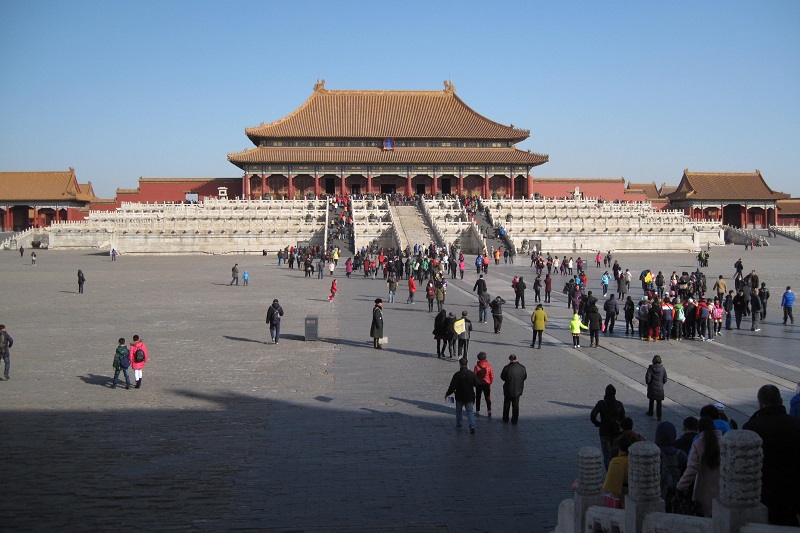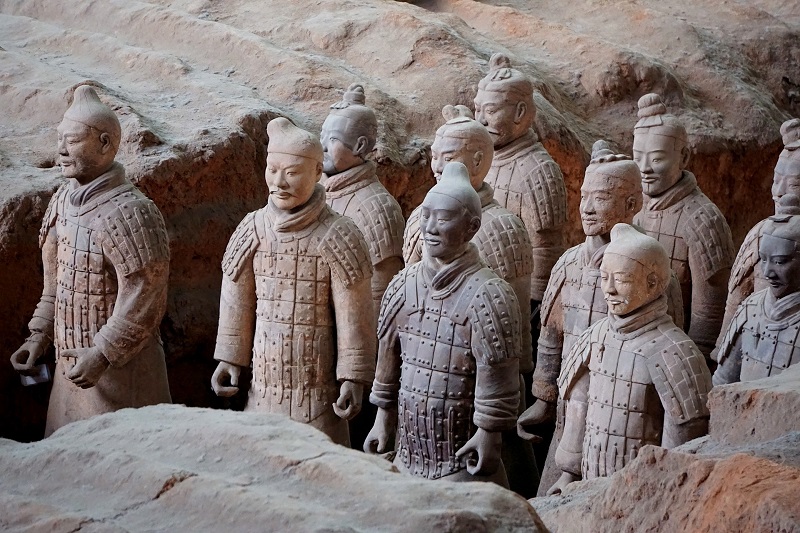| Dr. Tomasz Okraska |
One of the most interesting differences in the perception of China by the Chinese themselves and by Westerners is related to language issues. The meaning of the terms ‘Central State’ or ‘Middle Kingdom,’ which are used at times with regard to this country, is largly not really clear to us. In China, however, the corresponding term Zhōngguó is one of the official names for their homeland. In the past centuries, it reflected the way of thinking in which the emperor sitting on a dragon’s throne was not only the sovereign of China, but also – indirectly – the ruler of the entire world. According to their own world view, the Chinese had created the highest or even the only civilization, surrounded by a sea of barbarians, of whom those living in the neighborhood were the happiest, as the glow of Chinese culture flowed down on them.
Hall of Supreme Harmony in Beijing | photo: Tomasz Okraska
One of the most interesting differences in the perception of China by the Chinese themselves and by Westerners is related to language issues. The meaning of the terms ‘Central State’ or ‘Middle Kingdom,’ which are used at times with regard to this country, is largly not really clear to us. In China, however, the corresponding term Zhōngguó is one of the official names for their homeland. In the past centuries, it reflected the way of thinking in which the emperor sitting on a dragon’s throne was not only the sovereign of China, but also – indirectly – the ruler of the entire world. According to their own world view, the Chinese had created the highest or even the only civilization, surrounded by a sea of barbarians, of whom those living in the neighborhood were the happiest, as the glow of Chinese culture flowed down on them.
Inhabitants of the ‘Middle Kingdom’ had some reasons for such a perspective, since it resulted from the multitude of inventions that had been developed earlier than on the Old Continent. Consequently, it was a huge shock for them that, due to the weakness of the empire, they were dominated by Europeans in the 19th century. Today, in turn, after a century of disgrace and humiliation, the madness of the Maoist era, and the subsequent reconstruction, China is once again a great power. The Chinese often do not perceive their homeland as a conventional nation state, but rather as a permanent natural phenomenon (“China has always existed at an impressive cultural level’), and therefore, they regard the current international situation not as a new phenomenon, but as a return to a natural state of affairs in which the ‘Middle Kingdom’ dominates over others.
In the 21st century, Chinese politicians felt so confident at the helm of their growing power that they broke with the previous low-profile foreign policy of Deng Xiaoping’s 24-Character Strategy based on caution and self-restraint. The current leader, Xi Jinping, has already made it clear that China is a superpower, feels like a superpower, and will participate in world politics. At a time when the importance of the United States and the entire West is declining, the People’s Republic of China presents itself as a potential new leader, or even a champion of globalization and free trade – in opposition to US President Donald Trump. The global expansion has been underlined by the launch of Xi’s Crown Project, i.e. the Belt and Road Initiative, which is to further enlarge China’s economic sphere of influence. The huge number of Chinese projects on all continents has made it clear to the West that Francis Fukuyama’s predicted end of history, assuming the final global triumph of liberal democracy, is clearly outdated. The People’s Republic of China has proposed a different model for drawing some (but not all) ideas from the West in the economic sphere while maintaining the primacy of the communist party over the state and society. The Beijing Consensus, which is to replace the Washington Consensus of the early 1990s, assumes that it is possible to transfer Chinese solutions to other countries, for example on the African continent. However, at present it is difficult to notice such a tendency, and it is worth mentioning that many Chinese researchers have doubts about copying their model, claiming that the Chinese people themselves are necessary for its proper functioning.
Famous terracotta army located in the tomb of the first Chinese Emperor Qin Shi | photo: public domain
However, does the model even function properly in the PRC? It has a lot of internal problems: demographic imbalance, social stratification, ecological disaster, and growing internal debt are just a few of them. China’s reputation as the world’s factory is also slowly becoming obsolete – local workers want to earn more, and thus cheap production will no longer be possible. The irony is that Chinese companies are moving their own factories to Africa, where labor costs are lower, and at the same time they are not poisoning their own, but others countries’ environments. Moreover, the great protests in Hong Kong in 2019 have showed that not everyone is equally happy to live in the PRC. The Beijing authorities are also aware of various challenges. Thus, for example, Xi Jinping once said that China may become a superpower as late as in 2049.
The COVID-19 pandemic may be very important for the present and future perception of China. The fact that it began in the PRC and has spread on such a scale is not only a matter of chance, but also shows a weakness of the Chinese system. The voice of Li Wenliang, the doctor who warned about the epidemic, was not heard. Instead, he was detained by the police, and the local authorities concealed the information with the help of Beijing. Information issued by the government was chaotic and focused rather on intra-state propaganda than on the effectiveness of the implemented measures. At the same time, the PRC tried to change its image from a culprit to a savior by means of supplying (partly non-commercially) protective equipment to other countries. Despite its quality problems, the action allowed China to present itself as a responsible world power with a policy of “generosity.” It is noteworthy that many European countries are more eager to emphasize Chinese aid than EU aid, even though the latter has been more substantial. This shows the effectiveness of Chinese efforts in building soft power and shaping a positive image of the country over the past decades.
The article entitled ‘China – a giant with feet of terracotta?’ was published in ‘No Limits’, no. 2 (2) in 2020.
Contact
Dr. Tomasz Okraska
Faculty of Social Sciences at the University of Silesia
tomasz.okraska@us.edu.pl







